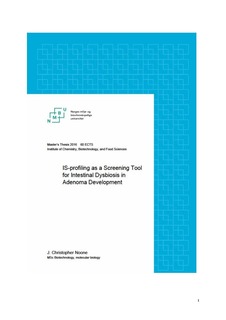| dc.description.abstract | The collective microbial genome of the human gut, the microbiome, is an essential component to the homeostasis and wellbeing of an individual. Dysbiosis here is implicated in several disorders, making it an important focal point for research. The current thesis evaluates a non-invasive method of analyzing the delicate balance of the normal intestinal flora in the quest for a establishing a screening method by which to facilitate the discovery of indications of colorectal cancer in its earliest stages.
The method, IS-profiling, is a fragment analysis of the bacterial 16S-23S rRNA inter-genic spacer region, using phylum specific fluorescent PCR primers. The species specific variation in IS-fragment length across patients’ intestinal flora produces a molecular fingerprint via capillary gel electrophoresis.
The method’s necessity for an efficient method of bacterial DNA extraction precipitated an evaluation of DNA extraction methods which led to the choice of the Stratec PSP Stool DNA Extraction Kit. It provided both sufficient amounts of bacterial DNA and the broadest bacterial diversity when compared to the other extraction methods tested here.
Stool samples were collected from two groups: 1. the healthy group, a group of presumed healthy volunteers; and 2. the polyp group, patients who were scheduled for removal of adenomas of the large intestine and/or rectum. The samples were collected 1-2 days before colonoscopy related bowel preparation.
In addition to IS-profiling of the bacterial composition, total bacterial 16S rRNA concentration, and human DNA concentration were also analyzed.
Results of group analysis using the jackknife test revealed an apparent similarity among the samples of the polyp group, placing them correctly in 91.67% of blind attempts. No such success was recorded in the healthy group (39.39% correct). IS-profiling revealed no obvious common peak pattern to either group. It is assumed that the success of the jackknife test is a due to some obscure complex relationship between several peaks inconspicuous to manual interpretation.
Results of 16S bacterial rRNA qPCR showed a healthy group average concentration that was approximately 10 ng/µl lower than that of the polyp group’s. Human DNA was present in a concentration over ten times greater in the polyp group compared to the healthy group.
In conclusion, IS-profiling presents itself as a useful, but possibly limited, tool for non-invasive screening for intestinal microbe dysbiosis. Our results suggest that, with the right analysis modules in place, changes in gut microbe profiles could be detected and followed up with additional tests. The limitations come, however, in the form species identification of peaks of interest, as well as in general knowledge of the 16S-23S IS-region; NCBI nucleotide database search yields only 58 871 items versus a 16S search which yielded 11 660 431 items at the time of this writing. | nb_NO |
